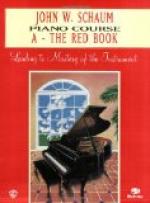The Mazourka of Liszt was recommended as one of the most delightful of his lighter pieces. The Waldesrauschen also, was termed charming, an excellent concert number. “Begin the first figure somewhat louder and slightly slower, then increase the movement and subdue the tone. Everything which is to be played softly should be practised forte."
Of Joachim Raff the Suite Op. 91 held the most important place. Each number received minute attention, the Giga being played by Ethelbert Nevin. The Metamorphosen received a hearing, also the Valse Caprice, Op. 116, of which the master was particular about the staccato left hand against the legato right. Then came the Scherzo Op. 74, the Valse Caprice and the Polka, from Suite Op. 71. Von Buelow described the little group of notes in left hand of middle section as a place where the dancers made an unexpected slip on the floor, and suggested it be somewhat emphasized. “We must make this little witticism,” he said, as he illustrated the passage at the piano.
“Raff showed himself a pupil of Mendelssohn in his earlier compositions; his symphonies will find more appreciation in the coming century—which cannot be said of the Ocean Symphony, for instance.”
Of Mendelssohn the Capriccios Op. 5 and 22 were played, also the Prelude and Fugue in E. Von Buelow deplored the neglect which was overtaking the works of Mendelssohn, and spoke of the many beauties of his piano compositions. “There should be no sentimentality about the playing of Mendelssohn’s music,” he said; “the notes speak for themselves.
“The return to a theme, in every song or instrumental work of his is particularly to be noticed, for it is always interesting; this Fugue in E should begin as though with the softest register of the organ.”
The subject of Brahms has been deferred only that it may be spoken of as a whole. His music was the theme of the second, and a number of the following lessons. Buelow was a close friend of the Hamburg master, and kept in touch with him while in Berlin. One morning he came in with a beaming face, holding up a sheet of music paper in Beethoven’s handwriting, which Brahms had discovered and forwarded to him. It seemed that nothing could have given Buelow greater pleasure than to receive this relic.
[Illustration: DR. WILLIAM MASON]
The first work taken up in class was Brahms’ Variations on a Handel theme. Von Buelow was in perfect sympathy with this noble work of Brahms and illumined many passages with clear explanations. He was very exact about the phrasing, “What cannot be sung in one breath cannot be played in one breath,” he said; “many composers have their own terms for expression and interpretation; Brahms is very exact in these points—next to him comes Mendelssohn. Beethoven not at all careful about markings and Schumann extremely careless. Brahms, Beethoven, and Wagner have the right to use their own terms. Brahms frequently uses the word sostenuto where others would use ritardando.”




